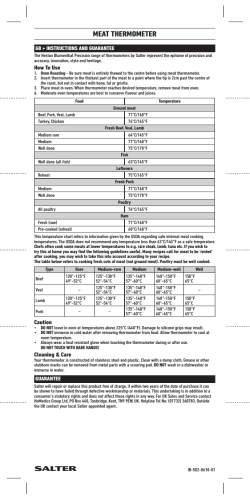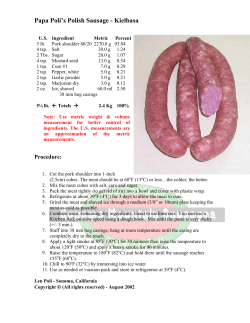
The latest eating quality science Dave Pethick improve the consumer eating experience
The latest eating quality science managing intramuscular fat and tenderness to improve the consumer eating experience Dave Pethick Lis Pannier & the Sheep CRC Meat Science Team Topics 1. Meat Standards Australia – history/current 2. New traits • Shear force tenderness • Intramuscular fat • MSA consumer taste panel 3. Predicting consumer taste panel response 4. MSA lamb Mark II – what it might look like ? Where have we come from ? Lamb loin tenderness in the 90’s 1997/98 retail audit – Safari et al. (2002) n = 907 MSA - underpinned by consumer testing • • • • Tenderness (0 – 100) Juiciness Liking of flavour Overall liking Unsatisfactory Good every day Better than every day Premium Science is recognised world wide Real people – real answers ! Conception Pre-slaughter Post-slaughter control control Genetics Sheep age Critical Control Points Hang Growth path (feed type & finishing) Chillers Ageing of meat Intramuscular fat Cut/ primal Selling method Value adding Pre-slaughter stress Cooking method Consumer Tenderness Juiciness Flavour Overall Liking Meat Standards Australia lamb MSA lamb - current • Consumer focused model to underpin the eating quality of lamb • It is a simple ‘in/out’ system with ‘rules’ for – Producers – Processors – Retailers Requirements eg • • • • • Fat score - GR ≥ 6mm (≥score 2) No eruption of permanent incisor teeth pH x temperature requirements (e-stimulation) Aging of meat for 5 days ……… Change is possible MSA data (2005) n = 806, optimal processing, fat & pH compliant What’s missing ? • • • • Continuous improvement Genetic effects Carcase grading Cuts grading The Information Nucleus (500 sires, 10,000 slaughter lambs) DORPER New traits (i) intramuscular fat • • • • • Juiciness, flavour, tenderness 4.2 ± 0.04% (Xbred mean) Ideal 4-6% Mod/high heritability Called marbling in beef New traits (ii) shear force tenderness • • • • • • Mechanical measure of Tenderness (kg or Newtons) Higher value = tougher Measured after electrical stimulation and 5 days aging Gene markers for this trait in sheep (& beef) Intramuscular fat reduces it Mod/high heritability Important correlations – genetic (2 years data 183 sires, 4,110 progeny) • LMY vs IMF -ve mod/high BAD • LMY vs SF5 +ve mod BAD • IMF vs SF5 -ve high GOOD LMY = lean meat yield SF5 = Shear force tenderness day 5 IMF = intramuscular fat So single focused selection on LMY will: • Increase shear force (tougher) • Reduce intramuscular fat (less juicy, less flavour & tougher) • BUT LMY is totally important for lamb So how can we protect eating quality ? Evolve an MSA Mark II • • • • Evolve an enhanced MSA lamb model Incorporating new Sheep CRC information Manage yield and eating quality Cuts grading Eating quality • But what does shear force and IMF mean to consumers ? • Will they pay more ? • …… MSA Lamb mark II Grade cuts into: 2* - Unsatisfactory 3* - Good every day 4* - Better than every day 5* - Premium Willingness to pay data (Price relative to 3*, n = number consumers) Mean n Ungrade 3* 4* 5* 1,858 49% 100% 147% 200% Australian consumers - lamb 3 star 4 star 5 star Sire variation – consumer tenderness Topside tenderness (Pannier et al. unpublished) Loin tenderness 97 sires, 745 lambs, 2 cuts per lamb, grilled Sire variation – consumer tenderness 16 points Topside tenderness 12 points Loin tenderness Likely sufficient to change rating 2* unsatisfactory 3* good every day 4* better than every day 5* premium Sire variation – consumer tenderness 4* Topside tenderness 3* Loin tenderness 5* Sire variation – consumer tenderness Topside tenderness 3* 2* Loin tenderness Remember - this is with ‘optimal’ processing • All carcases had e-stimulation • Product aged for 5 days What did consumers say about the 2 cuts ? Distribution of grades (745 lambs per cut) 2* 3* 4* 5* Short lion 7 34 35 24 % Topside 29 48 17 5 % Can we predict this grade ? IMF vs MSA consumer score IMF nails juicy and flavour 6 9 9 11 Shear force vs MSA consumer score Shear force nails tenderness 11 7 6 6 Other correlates • • • • • • Carcase fatness Carcase muscling Lean meat yield Carcase wt Colour ………… MSA Mark II • Currently too hard to measure shear force or intramuscular fat in the abattoir • Currently cannot grade a lamb carcase commercially • So EQ claims will be underpinned by: – in part the sires used – ideally carcase measures Consumer score breeding value • Use std genetic techniques to develop a consumer score breeding value for sires: – – – – – Consumer score Shear force tenderness Intramuscular fat Lean Meat Yield Other correlates ………… • Support with genomic prediction • Use the breeding value to underpin quality claims MSA Mark II – 2nd phase Grade individual carcases for LMY and meat quality • Develop better LMY prediction ‘on line’ • Develop meat quality and IMF measurement ‘on line’ – GR fat-o-meter II probe with electrical impedance – Wide wavelength vision system – Rhaman spectroscopy These are AMPC/MLA projects in progress Conclusions • Current MSA system is a simple no brainer • Processors/retailers are seeing the benefits • We still need producers to sign up – do it today ! • However it does not allow for continuous improvement and lean meat yield interactions Conclusions • Meat science phenotypes - shear force tenderness and intramuscular fat – – – – Heritable We know the key production factors that effect them Predictive of the consumer score Interact with lean meat yield • We will be able to develop a consumer score breeding value Conclusions • MSA mark II underpinned by consumer score sire breeding value • Cuts based grading down star ratings • Will allow us to select for Lean Meat Yield and Eating quality together Conclusions • Processors to their credit are investing in R&D for better carcase measurement systems • Are we heading for carcase grading at last ? – Lean meat yield – Eating quality Aussie lamb - premier meat on the Planet! Questions… Quick reality check Getting 4* cuts in moderate carcase wt Sth beef • Optimal processing ✔ • No hormones ✔ • Get’em young (< about 140 oss = 18-24 months) ✔ • Have just enough marble = solid score 1 (4-6% IMF) ✔ IMF breeding value Other correlates e.g LMY vs IMF LMY breeding value
© Copyright 2025










